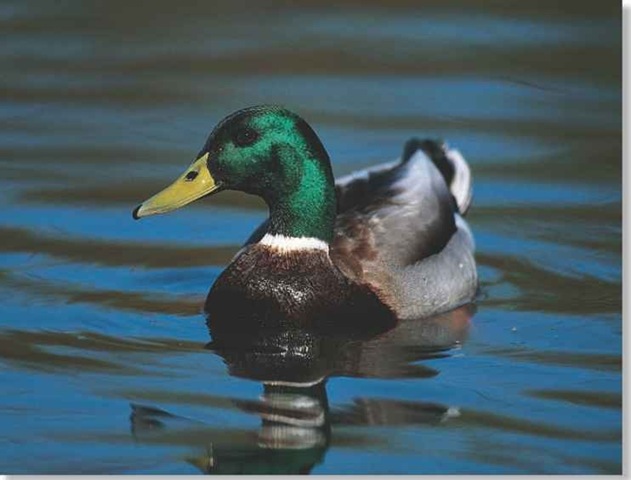ORDER
Anseriformes
FAMILY
Anatidae
GENUS & SPECIES
KEY FEATURES
• The world’s most abundant species of duck
• Feeds on submerged plants by upending and pushing its long neck underwater
• Male abandons his mate after egg-laying
• Ducklings stay close to their mother for protection, often swimming behind her in a long line
WHERE IN THE WORLD?
Found in a huge range that includes nearly all of Northern Hemisphere’s temperate zone; introduced populations in Australia and New Zealand

Lifecycle
The mallard can raise a family in any wetland habitat, including the smallest pool and park lake, but each pair must produce a large brood to ensure enough chicks survive.
Habitat
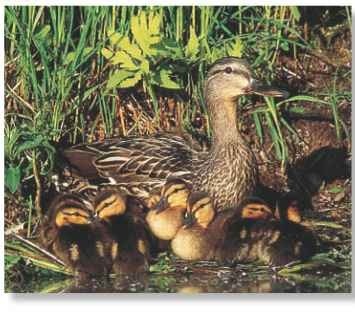
A Park life Even busy parks have quiet corners for nesting.
The mallard prefers to live in shallow waters with lush bankside vegetation. Although it can adapt to most every type of wetland, it ignores the deepest lakes and open seas.The mallard rarely moves far from its breeding grounds, but some fly to estuaries in winter; where there is a rich supply of food all year-round.
Mallards are tolerant of humans and are a common sight in garden ponds, park lakes and sewage farms.
Conservation
Although hunted, the mallard has a stable world population of 28 million birds. However, in some areas the species’ genetic purity is threatened by breeding with domesticated ducks.
Food & feeding
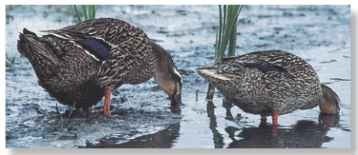
A Filter feeders Souplike mud at the water’s edge teems with a wide range of invertebrate prey.
The mallard employs a number of methods to find food. Out on the water, it paddles with its feet to disturb food items, which it then snaps up from the surface, or it sieves water through the sides of its bill to extract tiny animals. It up-ends in the water to browse water weed, or grab seeds, small snails and invertebrates from the bottom. On land, the mallard grazes short grass, browses shoots, and picks up whatever food it comes across, including scraps thrown by humans.
Behavior
Outside the breeding season, mallards gather in flocks of hundreds or even thousands of birds, which tend to take part in the same activity at the same time. For example, the whole flock may feed, preen, bathe or simply rest together. In late winter, the flocks disperse into groups of several pairs each to search for suitable nest sites. But, even during the breeding season, neighboring pairs of mallards often associate in loose groups.
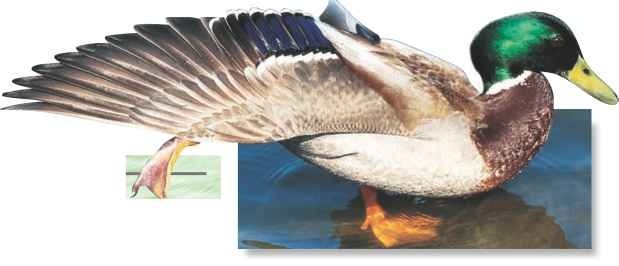
Only female mallards can “quack.” The male has a feeble, high-pitched call.
Both sexes molt their feathers in midsummer and become flightless for about 4 weeks.
Pools heated by thermal springs allow the mallard to stay in Iceland all winter.
Young mallards have many enemies, including bass, snapping turtles and raccoons.
Breeding
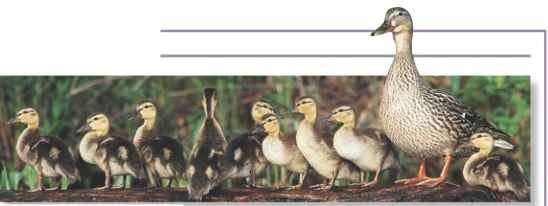
Groups of male mallards chase and display to females all winter long, but especially in February and March. Once a drake has attracted a mate, he stays at her side to prevent her mating with other males. When she has laid her clutch of 9-13 eggs, he takes no part in rearing the young. The downy chicks leave the nest 24 hours after hatching, and can feed themselves, but need their mother’s protection for two months. Even so, as few as one in ten reach adulthood.
A Single parent The drake (right) deserts his mate, so she cares for her large family alone.
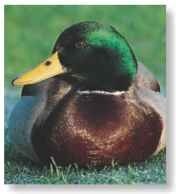
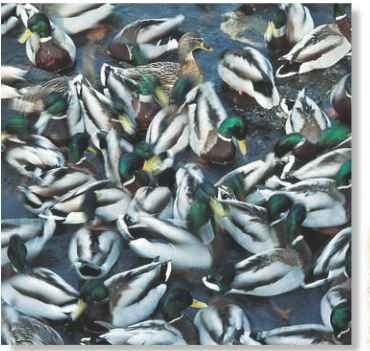
Well groomed Preening and wing-stretching maintain feathers.
A Feeding frenzy Large flocks soon form at rich feeding grounds.
water off a duck’s back
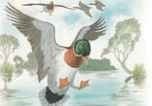
Land…
Several mallards drop down to a lake to feed.They spread their feet to act as brakes; just before hitting the water, they flap backward.
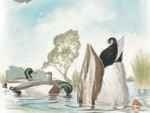
Feed…
While the mallards are upending to browse underwater weed, a peregrine falcon flies overhead in search of its own meal.
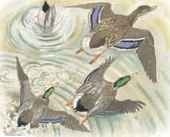
Fly…
Most of the mallards spot the falcon and leap into the air to fly to safety, but one drake is unaware of the danger and continues to feed.
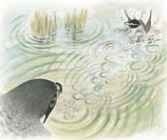
Dive
The lone mallard is, in fact, safe on the water, as the falcon hunts only in midair. The hunter heads off in search of airborne prey.
PROFILE
Mallard
A highly versatile body plan allows the mallard to exploit a wide range of feeding opportunities, making it the world’s most successful duck.
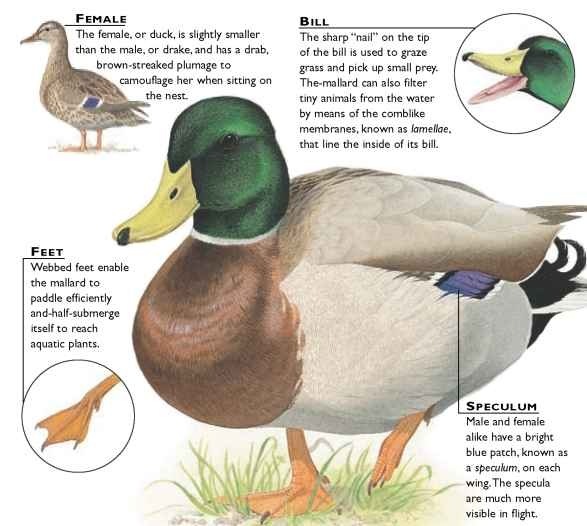
CREATURE COMPARISONS
From a distance, the northern shelduck (Tadorna tadorna) seems to have a patterned black-and-white plumage, as the species’ green head and orange-chestnut breast band are visible only up close. The male shelduck has a prominent “knob” on the bill.
A bird of Eurasia’s coastal mudflats and estuaries, the shelduck is rarely found far inland. It has a more specialized diet than the mallard, feeding on small shellfish, snails and worms from the mud.
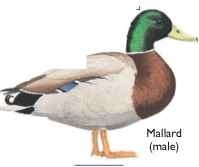

| VITAL | |
| STATISTICS | |
| Weight | 1.5-3.5 lbs. |
| Length | 20-26″ |
| Wingspan | 30-40″ |
| Sexual Maturity | 1 year |
| Breeding Season | February-June |
| Number of Eggs | 9-13 |
| incubation Period | About 28 days |
| Fledging _ Period | 50-60 days |
| Breeding Interval Typical Diet |
-1 year Shoots and ‘ seeds of aquatic plants, grass, insects, snails, worms |
| Lifespan | Up to 29 years in captivity |
RELATED SPECIES
• The mallard is I of 36 . species of surface-feeding duck in the genus Anas, which also includes the .Eurasian wigeon, A. penelope (male, below), and the pintails, shovelers and teals. Ducks are in the family Anatidae in the order Anseriformes, which includes geese and swans.

